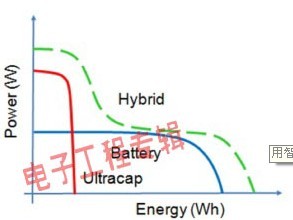Ioxus Inc.日前发布了一种重大的电池结构改良,将有助于缩减半导体和电池技术之间的差距──传统电池技术由于必须依赖无法改变的化学反应,成长脚步一直落后于半导体。
与采用主电池储能的方式不同,他们仅根据个别设备的需求,分别馈送少量电能给这些设备--这种崭新的混合式电容器/电池仅针对邻近设备的当前电能用量储存足够使用的能量。Ioxus Inc.表示,通过定义一种全新的分布式能源架构(distributed-energy architecture),该公司已经解决了“电池问题”。
“在许多应用中,我们的混合型超电容器(hybrid ultra-capacitors)都优于传统电池结构,”Ioxus联合创办人兼副总裁Chad Hall说。“当你需要少量或后备电源,我们便能提供可满足这些需求的解决方案,而且完全没有使用传统电池时会遇到的问题。”

该技术的适用领域包含了从简单到极复杂的应用。举例来说,一个简单的手电筒,只要用混合超电容器,就能在短短20秒内充饱可用2小时的电量。而一个复杂的汽车再生刹车系统(regenerative braking system)也能改用混合超电容器,在每次刹车和停下来时进行充电,而后,当你踩下油门便可重新启动汽车──这可望消除所有因汽车的停止和启动所造成的污染。
在汽车应用中,这种混合电容器能够以更具成本效益的方法,嵌入在汽车的各个不同应用中,它能够储存较少量的能源,为汽车的供电指示LED灯、车载电脑、电动车窗、电动门锁以及安全系统提供所需电力。而当汽车的主电池完全失效时,所有由混合式超级电容器提供电力的系统仍能顺利运作。此外,Ioxus公司也估计,若电动汽车采用这种分布式的混合式超级电容器,来取代原有单一大型集中式电池的设计,将能减少约20~30磅(约9~14KG)的重量。
市场上也有少数其他厂商声称拥有类似于Ioxus的混合动力超电容器,但这些产品都缺乏Ioxus的独特整合特性。例如,Evans Capacitor Co.公司推出了具备更高电压的低能量混合电容器,但与Ioxus的混合型超电容器相比,它更类似于一种独立型超电容器。而JM Energy Corp.公司也开发了“锂离子电容器”,但同样的,与Ioxus的混合型超电容器相比,它更像是一个锂离子电池。Ioxus也强调,该公司拥有的知识产权,使其产品的运作效能更优于Evan和JM Energy的产品。
混合式超级电容器”如何工作?
Ioxus的混合型超电容器结合了一种在分隔的绝缘板上累积电荷的电容器架构,以及化学储存的锂离子电池。这个采用与锂子电池相同化学品的混合型超电容器,将这些化学品分散到固态电极的表面,而不是将这些化学品嵌入到多孔电极中──这种缓慢的“插入”(intercalation)过程是进行充放电时所必要的。
因此,Ioxus的混合超电容器可以在几乎任何速率下进行充电和放电,这使其能够依照应用所需,去耗尽及释出大量或微小的电流。只有一个缺点:它们无法储存像传统电池那样多的电量,而且无法长久储存,不过,分布式架构可以补偿这些缺陷,Ioxus表示。

内置锂离子电池的Ioxus混合超电容器采用分布式储存架构,其运作效能甚至比该技术本身更加优良
“混合电容器可用来添加在需要供给能源的地方,”Hall说。“他们能储存比单一型超电容器更多的能量,而且,与锂离子电池相比,它可承受几乎无限量的充放电循环次数。”
混合型超电容器无法储存和锂离子电池一样多的电量,但它们可储存的电量大约会比单一型超电容器多出一倍,再加上几乎无限次数的充/放电循环特性。大部份的锂离子电池仅有数百次的充/放电周期,而一些强调长效应用的版本,其充/放电次数也局限在数千次。但混合型超电容器的充/放电次数通常是其产品寿命的好几倍--Ioxus的测试显示其产品充放电过期可超过2万次。
混合型超电容器还可提供比当前最强大的电池更高的即时启动电源──高达每千克5kW,其他更高价的电池可能仅能达到3kW/kg。Ioxus还声称,其混合型超电容器的能源效率可达95%,而最好的锂离子电池则仅有70%。
New architecture promises better battery
R. Colin Johnson
A change in architecture is promising to close the gap between semiconductor technology and battery technology, which has traditionally lagged behind semiconductors due to its dependence on unchangeable chemical reactions.
Instead of storing charge in a main battery—then doling it out to individual devices on demand—a new breed of hybrid capacitor/battery is storing just enough energy for an adjacent device for its exclusive use. Ioxus Inc. (Oneonta, N.Y.) says it is solving the "battery problem" by defining a new distributed-energy architecture.
"We have people using our hybrid ultra-capacitors for all types of applications that were challenging for traditional battery architectures," said Ioxus co-founder and Vice President Chad Hall. "When you need short-term or back-up power, we provide a device that satisfies those needs without all problems associated with traditional batteries."
Applications for the technology range from simple to complex. For instance, a simple flashlight using a hybrid ultra-capacitor can be charged in just 20 seconds, then used for up to two hours, according to Hall. And a complex regenerative braking system on an automobile can instead use a hybrid ultra-capacitor that charges every time you brake and stop, then simply restarts the car when you hit the gas--eliminating all the pollution caused by stop-and-start traffic, he said.
Automotive applications allow hybrid capacitors to be economically distributed around a vehicle, storing short-term energy where it is needed for powering LEDs, on-board computers, power windows, power door-locks and security systems. And in the event of a total failure—or even removal—of the main car battery, all hybrid ultra-capacitor powered systems will still work. Plus Ioxus estimates that electric vehicles making use of distributed hybrid ultra-capacitors rather than relying solely on a centralized battery can cut 20-to-30 pounds off their weight.
A handful of other makers claim to have similar hybrid ultra-capacitors to Ioxus', but none has duplicated its unique combination of features. For instance, Evans Capacitor Co. (East Providence, R.I.) has a higher-voltage lower-energy hybrid capacitor that is more akin to an ultra-capacitor alone than Ioxus' hybrid ultra-capacitors. And JM Energy Corp. (Yamanashi, Japan) has a "lithium-ion capacitor" that is more akin to a lithium-ion battery than Ioxus' hybrid ultra-capacitor. Ioxus, however, claims to have intellectual property that makes its approach work better than Evans' and be safer than JM Energy's.
How's it work?
Ioxus' hybrid ultra-capacitors combine the architecture of a capacitor—charge accumulating on plates separated by an insulator—with the chemical storage of a lithium-ion battery. Using the same chemistry as a lithium-ion battery, the hybrid ultra-capacitor distributes those chemicals onto the surface of a solid electrode, rather than embed the chemicals into a porous electrode where the slow process of intercalation is required to charge and discharge them.
As a result, Ioxus' hybrid ultra-capacitors can be charged and discharged at nearly any rate—allowing them to swallow-up and discharge-out vast or minuscule currents as required by an application. Their only downside is that they cannot store as much charge volume as a traditional battery, nor store it for as long, but the distributed architecture used by applications compensates for these shortcomings, according to Ioxus.
Ioxus hybrid ultracapacitors with built-in lithium-ion batteries enables distributed storage archtectures that works better than either technology alone.
"Hybrid capacitors can be added to supply energy right where it is needed," said Hall. "They store more energy than an ultracapacitor alone, and can endure nearly unlimited numbers of charge-discharge cycles compared to lithium-ion batteries."
Hybrid ultra-capacitors do not store as much charge as a lithium ion battery, but they do store about 100 percent more charge than an ultra-capacitor alone, plus provide almost unlimited charge/discharge cycling. Most lithium ion batteries can only be charged/discharged a few hundred times, and even special long-term versions are limited to a few thousand cycles. Hybrid ultra-capacitors, on the other hand, typically can be charged and discharged more times than the lifetime of the product in which they are being used—more than 20,000 cycles in tests conducted at Ioxus.
Hybrid ultra-capacitors also offer much more instant-on power than even the strongest battery—up to 5 kiloWatts per kilogram compared with 3kW/kg for even the highest priced batteries, according to Ioxus, which also claims that its hybrid ultra-capacitors are 95 percent energy efficient, compared with 70 percent for the best lithium ion batteries.